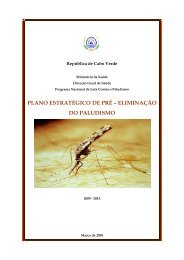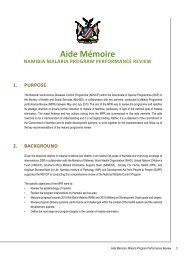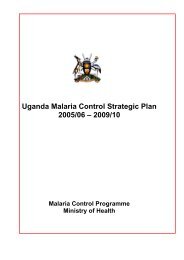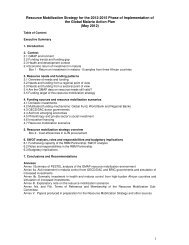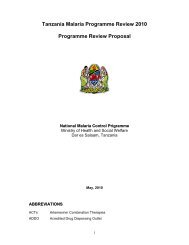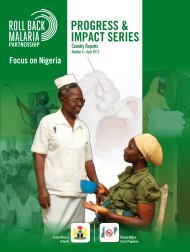Progress & ImPact serIes - Roll Back Malaria - World Health ...
Progress & ImPact serIes - Roll Back Malaria - World Health ...
Progress & ImPact serIes - Roll Back Malaria - World Health ...
Create successful ePaper yourself
Turn your PDF publications into a flip-book with our unique Google optimized e-Paper software.
Vectors: Vector behaviour contributes to the<br />
different epidemiologies observed. There are<br />
three highly efficient forest vector species<br />
in Asia, namely: An. minimus, An. Dirus, and<br />
An. Fluviatilis (21). An. dirus is a shade-loving<br />
deep-forest species: its archetypal breeding site<br />
is an elephant’s footprint filled with dead leaves.<br />
It has a long lifespan and a strong preference<br />
for primate blood (and in forest villages, human<br />
are often the most abundant primates). Despite<br />
sometimes being responsible for less than 5% of<br />
bites it can still cause the majority of infections.<br />
An. minimus is associated with the forest-fringe<br />
and breeds in the pools formed at the edges of<br />
mountain streams which may have emergent or<br />
dangling vegetation. An. minimus is more common<br />
than An. dirus but has a shorter lifespan than and<br />
is more zoophilic. An. fluviatilis is associated with<br />
intense malaria transmission in forested areas<br />
of Orissa, India, and is commonly found around<br />
slow moving streams, springs, and irrigation<br />
channels. The species is mainly zoophilic and<br />
only moderately long lived. An. culicifacies is<br />
responsible for much of the transmission of<br />
malaria in plain areas but it is not an efficient<br />
vector. It is an endophilic mosquito with females<br />
feeding outdoors and often resting indoors.<br />
Because it rests on the walls of houses it is easily<br />
controlled by IRS. Larvae of An. stephensi are<br />
commonly found in man-made structures such<br />
as water tanks, roof gutters, and collections of<br />
water on building sites in urban areas.<br />
Interventions: Development activities have had<br />
an important influence on malaria transmission<br />
over the years (21). In Kheda District, India,<br />
marshy land that sustained large populations of<br />
An. culicifacies was reclaimed for rice cultivation<br />
in the 1980s which led to a reduction in malaria<br />
transmission. In Indonesia, prawn and fish<br />
culture requiring high salinity proved injurious<br />
to An. sundiacus, thus eliminating its breeding<br />
in the coastal areas affected. Widespread<br />
deforestation in Asia has destroyed the habitats<br />
of some of the most efficient malaria vectors<br />
although in some cases natural forests may be<br />
replaced by oil palm plantations which are also<br />
associated with a high malaria risk (24).<br />
Preventive measures have also contributed to<br />
malaria control. More than 150 million people in<br />
the region were protected with IRS in 2009; IRS<br />
covers more than 5% of the population at highest<br />
risk in Bhutan, Democratic People’s Republic<br />
of Korea, India, Malaysia, Nepal, and Sri Lanka.<br />
Larvivorous fish are used in India, Indonesia,<br />
Myanmar, Sri Lanka, and Thailand. The number<br />
of ITNs distributed by national malaria control<br />
programmes between 2007 and 2009 was<br />
sufficient to protect approximately 70 million<br />
people with coverage potentially exceeding<br />
10% in Cambodia, the Lao People’s Democratic<br />
Republic, Malaysia, Sri Lanka, and Timor-Leste<br />
but in no case exceeding 20%. The apparent<br />
low coverage of preventive measures may be<br />
due to populations at risk being overestimated;<br />
when transmission is very focal the risk of<br />
transmission may be confined to only a small<br />
percentage of the population and preventive<br />
measures need to be targeted to ensure efficient<br />
use of resources (Box 3.2). It is also evident<br />
that populations acquire mosquito nets from<br />
sources other than national malaria control<br />
programmes and so are not accounted for in<br />
quantification exercises. These nets tend not to<br />
be treated with insecticide. Household surveys<br />
suggest that 80% of children under five years<br />
of age sleep under a mosquito net in Cambodia,<br />
the Lao People’s Democratic Republic, and<br />
Viet Nam, but only a small percentage of these<br />
were treated with insecticide (ITNs) (25). Hence<br />
the national malaria control programmes have<br />
emphasized treating existing mosquito nets as<br />
well as distributing new ITNs in order to boost<br />
the proportion of the population that have access<br />
to them. This strategy differs from that practiced<br />
in most other regions of the world in which<br />
retreatment of nets has been discontinued owing<br />
to the introduction of long-lasting insecticidal<br />
nets (LLINs) which do not need retreatment.<br />
DEFEATING MALARIA IN ASIA, THE PACIFIC, AMERICAS, MIDDLE EAST AND EuROPE<br />
41




